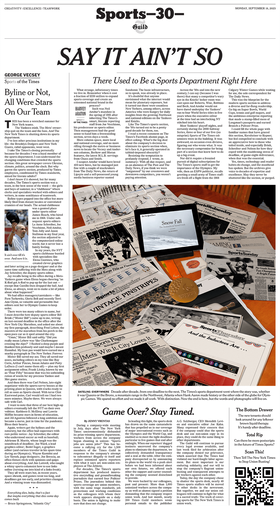|
 In a span of four months, the New York Times sports section has been disbanded and Sports Illustrated magazine appears to be on the verge of shutting down. Both moves can primarily be attributed to the rise of digital media which has contributed to these radical changes. But while people - myself included - have utilized digital media, it is still shocking to see two highly established print publications drastically change their operations. Back in July, the New York Times announced that The Athletic, a sports website they purchased the previous year, would replace their daily sports coverage. It was devastating news for a department that is one of the most prominent sports writing industries. Although The Times' coverage of sports has changed over the years, this move was mostly frowned upon by long time readers for many reasons. One of them is the fact that it came at the expense of the writers who have spent years working for the sports section, and were some of the best sports journalists in the country. A few well known writers for the sports section include Harvey Araton, George Vescay, and the late Dave Anderson. Now most of the writers have to seek alternate jobs such as covering the business side of sports instead of playoff games, or even work for a new company. Although I might have not read The Times’ sports section as long as other readers have, it was easy to appreciate the writers who made it possible to visualize their stories about great players or games. Even if their stories were about topics I was following, they might have presented a perspective of the story that I didn’t think about. I had the privilege of attending a New York Times sports writing class involving Harvey Araton and Ken Belson, who are two writers from the sports section. Hearing stories about their previous assignments were incredible, and it made me more interested in developing my writing. They taught me numerous skills such as different ways to begin a story, and being able to provide the entire picture even if all the information didn’t favor the topic. Their advice enabled me to improve my writing skills in the two weeks taking that class. Sports Illustrated magazine is another prominent print news outlet that is on the verge of shutting down. From 1954 to 2018, Sports Illustrated was known for coming out with a new magazine on a weekly basis. But because of more people beginning to read news off the internet, the magazine transitioned to publishing biweekly. By 2020, that frequency was reduced to a monthly basis where it remained that way until this year. Accusations that they were posting articles with artificial intelligence serving as fake authors also put a black eye on the company's reputation. While Arena Group, which owns Sports Illustrated, has stated their intentions to not disband Sports Illustrated magazine, it's difficult to see any future continuation of the iconic magazine. There are no bigger losers in these transactions than the writers from these publications and fans who read their articles. Reading Sports Illustrated magazine was a hobby I enjoyed for years. It was fun getting the chance to read an in-depth article about an athlete's impact on their team's reputation, or the season preview for football. Their covers were also intriguing because they gave you an idea of what the subject for their main story. However, that wouldn’t have been possible without their iconic images. Whether it was a triumphant Muhammad Ali standing over Sonny Liston, LeBron James in his St. Vincent-St. Mary high school uniform, or even the cover of Brandi Chastain above the story, you don’t get journalism presented like that online. The internet has certainly changed in the world of sports journalism, and it's understandable that some organizations would want to explore changes into how they operate for their content to better suit the public. However, sports journalism was initially presented through newspapers, and while I agree with trying to evolve news publishing, I don’t think it should come at the expense of completely abandoning the traditional methods. If two well-known companies could change their way of distributing sports coverage, it feels like every other sports journalism outlet is fair game. Maybe both publications will ultimately discover a way to bring back the print journalism that defined them for so many decades. For now, all those respected journalists and readers who enjoyed their work suffer from these decisions. Comments are closed.
|
Date Published
July 2024
Categories |

 RSS Feed
RSS Feed